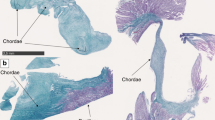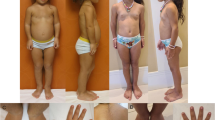Abstract
Thanatophoric dysplasia (TD), the most common neonatal lethal skeletal dysplasia, affects one out of 20,000 live births. Affected individuals display features similar to those seen in homozygous achondroplasia. Mutations causing achondroplasia are in FGFR3, suggesting that mutations in this gene may cause TD. A sporadic mutation causing a Lys650Glu change in the tyrosine kinase domain of FGFR3 was found in 16 of 16 individuals with one type of TD. Of 39 individuals with a second type of TD, 22 had a mutation causing an Arg248Cys change and one had a Ser371 Cys substitution, both in the extracellular region of the protein. None of these mutations were found in 50 controls showing that mutations affecting different functional domains of FGFR3 cause different forms of this lethal disorder.
This is a preview of subscription content, access via your institution
Access options
Subscribe to this journal
Receive 12 print issues and online access
$209.00 per year
only $17.42 per issue
Buy this article
- Purchase on Springer Link
- Instant access to full article PDF
Prices may be subject to local taxes which are calculated during checkout
Similar content being viewed by others
References
Orioli, I., Castilla, E. & Barbosa-Neto, J. The birth prevalence rates tor the skeletal dysplasias. J. med. Genet. 23, 328–332 (1986).
Maroteaux, P., Lamy, M. & Robert, J.-M. Le nanisme thanatophore. Presse Med. 49, 2519–2524 (1967).
Shah, K., Astlay, R. & Cameron, A. Thanatophoric dwarfism. J. med. Genet. 10, 243–252 (1973).
Kaufman, R., Rimoin, D., McAllster, W. & Klssane, J. Thanatophoric dwarfism. Am. J. Dis. Child. 120, 53–57 (1970).
Stensvold, K., Ek, J. & Hovland, A.R., An Infant with thanatophoric dwarfism surviving 169 days. Clin. Genet. 29, 157–159 (1986).
Tonoki, H. A boy with thanatophoric dysplasia surviving 212 days. Clin. Genet. 30, 415–416 (1987).
MacDonald, I., Hunter, A., MacLeod, P. & MacMurray, S. Growth and development In thanatophoric dysplasia. Am. J. med. Genet. 33, 508–512 (1989).
Langer, L.O. et al. Thantophoric dysplasia and clovsrleaf skull. Am. J. med. Genet. 3, 167–179 (1987).
Norman, A., Rimmer, S., Landy, S. & Donnai, D. Thanatophoric dysplasia of the straight-bone type (type 2). Clin. Dysmorphol. 2, 115–120 (1992).
Ullrich, A. & Schlesslnger, J. Signal transduction by receptors with tyroslne kinase activity. Cell 61, 203–212 (1990).
Johnson, D.E. & Williams, L.T. Structural and functional diversity in the fgf receptor mufflgene family. Adv. Cancer Res. 60, 1–41 (1993).
Ueno, H., Gunn, M., Dell, K., Tseng, A. Jr. & Williams, L. A truncated form of fibroblast growth factor receptor 1 Inhibits signal transduction by multiple types of fibroblast growth factor receptor. J. biol. Chem. 267, 1470–1476 (1992).
Partanen, J. et al. FGFR-4,a novel fibroblast growth factor receptor with a distinct expression pattern. EMBO J. 10, 1347–1354 (1991).
Peters, K., Ornitz, D., Werner, S. & Williams, L. Unique expression pattern of the FGF receptor 3 gene during mouse organogenesls. Dev. Biol. 155, 423–430 (1993).
Shiang, R. et al. Mutations in the transmembrane domain of FGFR3 cause the most common genetic form of dwarfism,achondroplasia. Cell 78, 335–342 (1994).
Rimoin, D.L. & Lachman, R.S. Genetic disorders of the osseous skeleton. In McKusickís Heritable Disorders of Connective Tissue (ed. Brighton,P. ) 557–689 (Mosby-Yearbook,Inc.,Missouri,1993).
Hecht, J.T., Francomano, C.A., Horton, W.A. & Annegers, J.F. Mortality in achondroplasia. Am. J. hum. Genet. 41, 454–464 (1987).
Keegan, K., Johnson, D.E., Williams, L.T. & Hayden, M.J. Isolation of an additional member of the fibroblast growth factor receptor family,FGFR3. Proc. natn. Acad. Sci. U.S.A. 88, 1095–1099 (1991).
Thompson, L.M. et al. A gene encoding a fibroblast growth factor receptor isolated from the Huntingtonís disease gene region of human chromosome 4. Genomics 11, 1133–11142 (1991).
Reardon, W. et al. Mutations in the fibroblast growth factor receptor 2 cause Crouzon syndrome. Nature Genet. 8, 98–103 (1994).
Jabs, E.W. et al. Jackson Weiss and Crouzon syndromes are allellc with mutations In fibroblast growth factor receptor 2. Nature Genet. 8, 275–279 (1994).
Muenke, M. et al. A common mutation in the fibroblast growth factor receptor 1 gene in Pfeiffer syndrome. Nature Genet. 3, 269–274 (1994).
Wilkie, A.O.M. et al. Apert syndrome results from localized mutations of FGFR2 and is allellc with Crouzon syndrome. Nature Genet. 9, 163–172 (1995).
Rutland, P. et al. Identical mutations in the FGFR2 gene cause both Pfeiffer and Crouzon syndrome phenotypes. Nature Genet. 9, 173–176 (1995).
Corsello, G., Maresi, E., Rossi, C., Giuffre, L. & Cittadini, E. Thanatophoric dysplasia in monozygotlc twins discordant for cloverieaf skull: Prenatal diagnosis,clinical,and pathological findings. Am. J. med. Genet. 42, 122–126 (1992).
Horton, W.A., Hams, D.J. & Collins, D.L., Disorders for the Kleeblattschadel anomaly in monozygotic twins with thanatophoric dysplasia. Am. J. med. Genet. 15, 97–101 (1983).
Knisely, A. & Ambler, M. Temporal-lobe abnormalities in thanatophoric dysplasia. Pediat. Neurosci. 14, 169–176 (1988).
Coulter, C.L., Leach, R.W., Brumback, R.A. & Schaefer, G.B. Cerebral abnormalities in thanatophoric dysplasia. Child. Nerv. Sys. 7, 21–26 (1991).
Wongmongkolrit, T., Bush, M. & Roessmann, U. Neuropathological findings in thanatophoric dysplasia. Arch. Path. lab. Med. 107, 132–135 (1983).
Bellot, F. et al. Ligand-induced transphosphorylation between different FGF receptors. EMBO J. 10, 2849–2854 (1991).
Dionne, C.A. et al. Cloning and expression of two distinct high-affinity receptors cross-reacting with acidic and basic fibroblast growth factors. EMBO J. 9, 2685–2692 (1990).
Johnson, D.E., Lee, P.L., Lu, J. & Williams, L.T. Diverse forms of a receptor for acidic and basic fibroblast growth factors. Molec. cell. Biol. 10, 4728–4736 (1990).
Sharony, R., Browne, C., Lachman, R.S. & Rimoin, D.L. Prenatal diagnosis of the skeletal dysplasias. Am. J. Ob. Gyn. 169, 668–675 (1993).
Escobar, L., Bixler, D. & Padilla, L.M. Quantitation of craniofacial abnormalities in utero: Fetal alcohol and crouzon syndromes and thanatophoric dysplasia. Am. J. med. Genet. 45, 25–29 (1993).
Weiner, C., Williamson, R. & Bonsib, S. Sonographic diagnosis of cloverieaf skull and thanatophoric dysplasia in the second trimester. J. clin. Ultrasound 14, 463–465 (1986).
Sheffield, V.C., Cox, D.R., Lerman, L.S. & Myers, R.M. Attachment of a 40 base pair G+C sequence (GC clamp) to genomic DMA fragments by the polymerase chain reaction results in improved detection of single base changes. Proc. natn. Acad. Scl. U.S.A. 86, 232–236 (1989).
Lerman, L.S. & Silverstein, K. Computation simulation of DMA melting and its application to denaturing gradient gel electrophoresis. Meth. Enzymol. 155, 482–501 (1987).
Author information
Authors and Affiliations
Rights and permissions
About this article
Cite this article
Tavormina, P., Shiang, R., Thompson, L. et al. Thanatophoric dysplasia (types I and II) caused by distinct mutations in fibroblast growth factor receptor 3. Nat Genet 9, 321–328 (1995). https://doi.org/10.1038/ng0395-321
Received:
Accepted:
Issue Date:
DOI: https://doi.org/10.1038/ng0395-321
This article is cited by
-
Prenatal trio-based whole exome sequencing in fetuses with abnormalities of the skeletal system
Molecular Genetics and Genomics (2022)
-
A primer on skeletal dysplasias
Japanese Journal of Radiology (2022)
-
Autosomal dominant familial acanthosis nigricans caused by a C-terminal nonsense mutation of FGFR3
Journal of Human Genetics (2021)
-
Growth Topics in FGFR3-Related Skeletal Dysplasias
Current Treatment Options in Pediatrics (2021)
-
Evaluation of FGFR inhibitor ASP5878 as a drug candidate for achondroplasia
Scientific Reports (2020)



